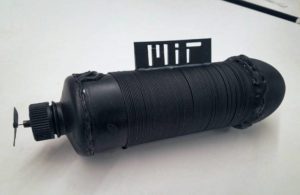
This submarine drone is powered by a 20-meter-long fiber battery that is wrapped on its surface. [Courtesy of the researchers]
Researchers at MIT say they developed a rechargeable lithium-ion battery in the form of a fiber that could be woven into fabrics.
The researchers say the battery, developed in the form of an ultra-long fiber, could enable a variety of wearable electronic devices and may even be used to make 3D-printed batteries in a multitude of shapes, according to a news release.
According to the researchers, they see possibilities for self-powered communications, sensing and computational devices that could be worn like ordinary clothing. Additionally, the researchers see the possibility for use in devices whose batteries could also double as structural parts.
Published in the journal Materials Today, results from a proof of concept showed that the world’s longest flexible fiber battery — at 140 meters long — could be manufactured to arbitrarily long lengths. Previously, researchers had demonstrated fibers that contain a wide variety of electronic components, including light-emitting diodes, photosensors, communications and digital systems.
Many of the fibers are weavable and washable, making them practical for use in wearable products. However, they have so far relied on an external power source, the researchers say, so the new fiber battery could enable such devices to be completely self-contained.
The fiber battery is manufactured using novel battery gels and a standard fiber-drawing system that starts with a larger cylinder containing all the components before heating it to just below its melting point. The material is drawn through a narrow opening to compress all parts to a fraction of their original diameter while maintaining the original arrangement of parts.
MIT postdoc Tural Khudiyev said previous attempts structured batteries with key materials on the outside of the fiber, while the latest system embeds lithium and other materials inside the fiber with a protective coating on the outside to make it stable and waterproof. He said it represents the first demonstration of a sub-kilometer-long fiber battery that is both sufficiently long and highly durable to have practical applciations.
So far, the 140-meter fiber has an energy storage capacity of 123 milliamp-hours, which can charge smartwatches or phones.
“The beauty of our approach is that we can embed multiple devices in an individual fiber,” former MIT postdoc Jung Tae Lee said. “Unlike other approaches which need integration of multiple fiber devices. … When we integrate these fibers containing multi-devices, the aggregate will advance the realization of a compact fabric computer.”
The material can also be used in 3D printing or custom-shape systems to create solid objects.
“This is the first 3D printing of a fiber battery device,” Khudiyev said. “If you want to make complex objects” through 3D printing that incorporate a battery device, this is the first system that can achieve that. After printing, you do not need to add anything else, because everything is already inside the fiber, all the metals, all the active materials. It’s just a one-step printing. That’s a first.”
The research team applied for a patent on the process and continues to develop improvements in power capacity and variations on materials. Khudiyev believes the fiber batteries could be ready for use in commercial products within a few years.
MIT’s MRSEC program of the National Science Foundation, the U.S. Army Research Laboratory through the Institute for Soldier Nanotechnologies, the National Science Foundation’s graduate research fellowship program, and the National Research Foundation of Korea all supported the research.